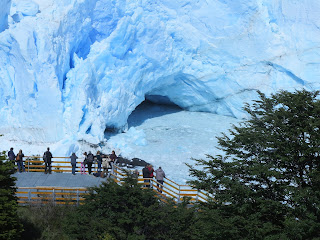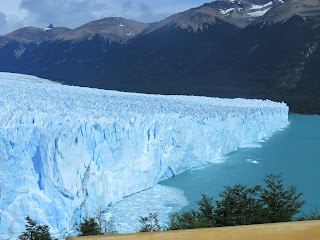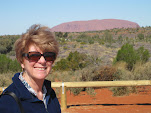Dec 9 - Friday - We had breakfast, got out pack lunches and sat and waited for Alejandro, our private guide. Our focus today was the Perito Moreno Glacier, a large glacier with 3 faces (noses he called them) north, south, and east. We drove for about 50 minutes. During the drive Alejandro told us about the geology, climate, local people, history. It was the most interested 50 minutes I've spent in years.
A few highlights: The Chileans came over the Andes, planted the Chilean flag and the Argentinians began to lose land. That's how Chile now owns Punta Arenas. The Argentinians decided the best way to keep the land was to import people to Patagonian, Argentina. Swiss, Austrians, and Germans settled in the northern mountains. That was an area more like home for them. The Welsh, angry at the time about English rule, settled just south of them. No one wanted the extreme south, so the Argentinians gave away 10,000 hectares of land each to the British to lure them to come. Many came. They brought sheep which is one of the mainstays of the economy in Patagonia.
The British established a town in a lake at the foot of the glacier. In 1917 their town was inundated by flood waters when part of the glacier wall broke away, and a lake that had built up behind it was set loose. In 1937 an English engineer who had been working on roads in the area and was supplied with TNT, checked the glacier for the townsfolk, who had rebuilt their town. He decided that the glacier was again backing up water in a lake behind it. He felt that they should blow up the glacier wall. They used his TNT. The glacier absorbed the explosion, and nothing happened. Bombers were brought in from Buenos Aires. They made 2 runs past the glacier that ended with the same odd effect. Nothing happened, the glacier absorbed the blasts. The real issue is that glaciers are ice. The water had to be deep enough for the glacier to float before the floods began (90% of the height of the ice). In 1939 the water did get deep enough, the glacier floated, and tons of water formed a tsunami that again inundated the town and the forest. The few houses that remain are built on cliffs overlooking the former town.
Below are three photos of a piece of the glacier sliding into the lake. The larger slides seemed more like avalanches than huge chunks dropping down.
After our walk we met Alejandro and we were driven to a boat to get close to the southern wall of the glacier. Some chunks slide in, but I guess I was waiting for a titanic fall. I must be getting jaded. But the views were spectacular. Here's a surprise, standing on the roof deck of a boat surrounded by ice is rather cold. Who knew?
There was bright sunlight today. The light shining off the glacier was amazing. It made an eerie glow beyond the front peaks.
If you look carefully in the photo below you can see some dark spots in a line. There are actually two lines, one slightly to the left, one to the right. In the next photo I tried to enlarge those dark spots.
A few highlights: The Chileans came over the Andes, planted the Chilean flag and the Argentinians began to lose land. That's how Chile now owns Punta Arenas. The Argentinians decided the best way to keep the land was to import people to Patagonian, Argentina. Swiss, Austrians, and Germans settled in the northern mountains. That was an area more like home for them. The Welsh, angry at the time about English rule, settled just south of them. No one wanted the extreme south, so the Argentinians gave away 10,000 hectares of land each to the British to lure them to come. Many came. They brought sheep which is one of the mainstays of the economy in Patagonia.
The British established a town in a lake at the foot of the glacier. In 1917 their town was inundated by flood waters when part of the glacier wall broke away, and a lake that had built up behind it was set loose. In 1937 an English engineer who had been working on roads in the area and was supplied with TNT, checked the glacier for the townsfolk, who had rebuilt their town. He decided that the glacier was again backing up water in a lake behind it. He felt that they should blow up the glacier wall. They used his TNT. The glacier absorbed the explosion, and nothing happened. Bombers were brought in from Buenos Aires. They made 2 runs past the glacier that ended with the same odd effect. Nothing happened, the glacier absorbed the blasts. The real issue is that glaciers are ice. The water had to be deep enough for the glacier to float before the floods began (90% of the height of the ice). In 1939 the water did get deep enough, the glacier floated, and tons of water formed a tsunami that again inundated the town and the forest. The few houses that remain are built on cliffs overlooking the former town.
The flatlands where the floods occurred.
Our drive ended at the Los Glaciares National Park. Below are some views of both the glacier and the facilities.
The Argentinians set up a series of metal catwalks attached to the side of a hill opposite the glacier. Charlie and I took a walk on the catwalks to get lots of photos. You could hear the glacier cracking, and every once in a while a chunk would calve off into the lake below. There was a cave in the ice. When the roof of that structure calved the ice falling into the water made a sound like a cannon.
The cave
The north wall of the glacier
The south wall of the glacier
When a big chunk calved off it would leave a circular ring where the ice fell into the water.
Below are three photos of a piece of the glacier sliding into the lake. The larger slides seemed more like avalanches than huge chunks dropping down.
After our walk we met Alejandro and we were driven to a boat to get close to the southern wall of the glacier. Some chunks slide in, but I guess I was waiting for a titanic fall. I must be getting jaded. But the views were spectacular. Here's a surprise, standing on the roof deck of a boat surrounded by ice is rather cold. Who knew?
There was bright sunlight today. The light shining off the glacier was amazing. It made an eerie glow beyond the front peaks.
Us on the boat.
We did see some calving here too.
If you look carefully in the photo below you can see some dark spots in a line. There are actually two lines, one slightly to the left, one to the right. In the next photo I tried to enlarge those dark spots.
People can hike onto the glacier. That really didn't appeal to us, but obviously stomping around on the ice was popular.
A few "pebbles" fall into the water. The scale of this ice wall is phenomenal! It's about 250 feet high.
We drove back to the hotel and had a bit of a rest and a shower. Tomorrow we're off to Ushuaia, our farthest visit south.






















No comments:
Post a Comment